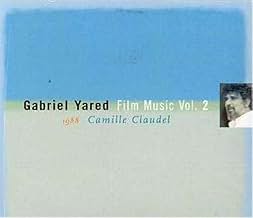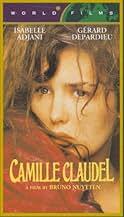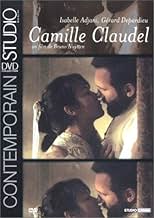IMDb-BEWERTUNG
7,3/10
7722
IHRE BEWERTUNG
Camille Claude beeindruckt Auguste Rodin. Er stellt sie als Assistentin ein, aber bald beginnt Camille, für sich selbst zu arbeiten und sie wird auch seine Geliebte. Doch nach einer Weile mö... Alles lesenCamille Claude beeindruckt Auguste Rodin. Er stellt sie als Assistentin ein, aber bald beginnt Camille, für sich selbst zu arbeiten und sie wird auch seine Geliebte. Doch nach einer Weile möchte sie aus seinem Schatten heraus.Camille Claude beeindruckt Auguste Rodin. Er stellt sie als Assistentin ein, aber bald beginnt Camille, für sich selbst zu arbeiten und sie wird auch seine Geliebte. Doch nach einer Weile möchte sie aus seinem Schatten heraus.
- Für 2 Oscars nominiert
- 7 Gewinne & 14 Nominierungen insgesamt
Empfohlene Bewertungen
10Banquo13
Isabelle Adjani is stunning as the title character in this rich and passionate film. I am amazed anytime an actor or actresses changes physically in the part of a film (and without tons of make-up and special effects, either!)and Adjani does this remarkably well! We as an audience are just as stunned as Eugene Blot when he finds Camille drunk and spiraling into the depths of madness. Her appearance is nothing less than shocking.
The film as a whole is engaging with a whirlwind of emotions--rage, sadness, torment, bliss; by the time the nearly 3 hours are up, I am exhausted. Adjani and Depardieu are part of that emotional energy as they passionately go at it--sex, sculpture and anger; especially when it comes to the latter. It is almost worth it to stop reading the subtitles and listen to them rage and lash out at one another.
Adjani is powerful in so much of this film...I am amazed she didn't receive that best actress Oscar she was up for. Her torment and pain is riveting--especially in French. I am glad they did not decide to dub this film into English; hearing Adjani sob and ask "Pourquoi? Pourquoi?" would be empty with her mouthing the words "Why? why?" in English.
The film as a whole is a bit long, but overall is stunning. The sad epilogue is even sadder if you know that Claudel's remains were interred in a mass grave after her brother Paul failed to claim them from her original grave [the asylums only interred bodies in individual plots for a certain amount of time; space was at a premium.] So, the brilliant Camille Claudel's remains ended up in an unmarked grave mixed in with others who went unclaimed, as well.
The film as a whole is engaging with a whirlwind of emotions--rage, sadness, torment, bliss; by the time the nearly 3 hours are up, I am exhausted. Adjani and Depardieu are part of that emotional energy as they passionately go at it--sex, sculpture and anger; especially when it comes to the latter. It is almost worth it to stop reading the subtitles and listen to them rage and lash out at one another.
Adjani is powerful in so much of this film...I am amazed she didn't receive that best actress Oscar she was up for. Her torment and pain is riveting--especially in French. I am glad they did not decide to dub this film into English; hearing Adjani sob and ask "Pourquoi? Pourquoi?" would be empty with her mouthing the words "Why? why?" in English.
The film as a whole is a bit long, but overall is stunning. The sad epilogue is even sadder if you know that Claudel's remains were interred in a mass grave after her brother Paul failed to claim them from her original grave [the asylums only interred bodies in individual plots for a certain amount of time; space was at a premium.] So, the brilliant Camille Claudel's remains ended up in an unmarked grave mixed in with others who went unclaimed, as well.
I couldn't take my eyes away from the television, and it wasn't because it was in French with English subtitles. This is a superbly acted film depicting two artists' work, passion, fears and ultimately her downfall, falling victim to her own creative mind.
Now that this wonderful story will be a Broadway musical in 2003 under the finesse of Frank Wildhorn and the magical voice of lovely Linda Eder, one will certainly appreciate familiarizing themselves with the background of the subject of this movie, Camille Claudel.
Now that this wonderful story will be a Broadway musical in 2003 under the finesse of Frank Wildhorn and the magical voice of lovely Linda Eder, one will certainly appreciate familiarizing themselves with the background of the subject of this movie, Camille Claudel.
In the realm of art and cinema, there are tales of triumph, stories of struggle, and then there is the heart-wrenching saga of Camille Claudel, masterfully portrayed in Bruno Nuytten's film. This cinematic masterpiece delves into the life of the 19th-century French sculptor Camille Claudel, bringing her intricate story to life with unparalleled grace and depth. It's a tale of passion, creativity, madness, and societal restraint, told through the lens of Camille's artistry.
Camille Claudel, portrayed by the brilliant Isabelle Adjani, was a remarkable sculptor. The film showcases her life journey, from her upbringing in the small village of Villeneuve-sur-Fère to her artistic blossoming in Paris under the guidance of none other than the renowned Auguste Rodin. Their encounter, a passionate rendezvous between student and master, ignites a profound and turbulent love affair.
The film captures the beauty of Camille's artistry as her hands meticulously shape exquisite works of art. Her sculptures are a testament to her modernity, audacity, and unwavering dedication to the craft. They reflect the struggles, the passions, and the relentless pursuit of her artistry, providing glimpses into her inner world. While Camille's works are captivating, her relationship with Rodin brings both admiration and scorn. Their union is a blend of student-mentor dynamics, artistic collaboration, and intense romantic involvement, leading to unrelenting societal judgment.
Yet, Camille is not solely defined by her artistic genius. Her life is marked by isolation, frustration, and the anguish of an unrequited love, intensified by Rodin's continued relationship with Rose Beuret. She becomes an artist alone, adrift in the sea of her emotions. Her world is a whirlpool of despair, loneliness, and financial struggle, interspersed with visions and obsessions that haunt her.
Camille's family disapproves of her lifestyle and choices, and the art world misunderstands her uniqueness. Her mother despises her perceived recklessness, her brother Paul harbors jealousy for her extraordinary talent, and her sister Louise schemes to claim Camille's inheritance. In the face of relentless adversity, Camille is committed to her artistic expression and personal journey.
Despite her distance from Rodin, he continues to support her with discreet acts of kindness. He writes letters to secure precious materials for her work, and he introduces her to influential art critics. However, these critics view her art as unconventional, mirroring her uniqueness and inner turmoil.
Camille Claudel, the artist par excellence, lived a life of wealth, beauty, determination, and promise in her youth. Still, her brilliance was overshadowed by the tragedy of her later years. She was left unrecognized, locked away in isolation, where her art became both her refuge and her torment. It was here, within the confines of her solitude, that she chose to destroy many of her own creations.
Camille's story is a testament to a life of artistry and heartache, unacknowledged talent, and the agony of unrealized dreams. Her impact on the art world was long overdue for recognition. Almost a century later, in 1988, her life's narrative was finally shared with the world through Bruno Nuytten's film, marking a turning point in the rediscovery of her art and her enduring legacy. The Musée Camille Claudel, opened in 2017 in Nogent-sur-Seine, France, stands as a national museum, dedicated to preserving and celebrating her art, ensuring that Camille Claudel's work rightfully finds its place in the annals of art history.
Camille Claudel, portrayed by the brilliant Isabelle Adjani, was a remarkable sculptor. The film showcases her life journey, from her upbringing in the small village of Villeneuve-sur-Fère to her artistic blossoming in Paris under the guidance of none other than the renowned Auguste Rodin. Their encounter, a passionate rendezvous between student and master, ignites a profound and turbulent love affair.
The film captures the beauty of Camille's artistry as her hands meticulously shape exquisite works of art. Her sculptures are a testament to her modernity, audacity, and unwavering dedication to the craft. They reflect the struggles, the passions, and the relentless pursuit of her artistry, providing glimpses into her inner world. While Camille's works are captivating, her relationship with Rodin brings both admiration and scorn. Their union is a blend of student-mentor dynamics, artistic collaboration, and intense romantic involvement, leading to unrelenting societal judgment.
Yet, Camille is not solely defined by her artistic genius. Her life is marked by isolation, frustration, and the anguish of an unrequited love, intensified by Rodin's continued relationship with Rose Beuret. She becomes an artist alone, adrift in the sea of her emotions. Her world is a whirlpool of despair, loneliness, and financial struggle, interspersed with visions and obsessions that haunt her.
Camille's family disapproves of her lifestyle and choices, and the art world misunderstands her uniqueness. Her mother despises her perceived recklessness, her brother Paul harbors jealousy for her extraordinary talent, and her sister Louise schemes to claim Camille's inheritance. In the face of relentless adversity, Camille is committed to her artistic expression and personal journey.
Despite her distance from Rodin, he continues to support her with discreet acts of kindness. He writes letters to secure precious materials for her work, and he introduces her to influential art critics. However, these critics view her art as unconventional, mirroring her uniqueness and inner turmoil.
Camille Claudel, the artist par excellence, lived a life of wealth, beauty, determination, and promise in her youth. Still, her brilliance was overshadowed by the tragedy of her later years. She was left unrecognized, locked away in isolation, where her art became both her refuge and her torment. It was here, within the confines of her solitude, that she chose to destroy many of her own creations.
Camille's story is a testament to a life of artistry and heartache, unacknowledged talent, and the agony of unrealized dreams. Her impact on the art world was long overdue for recognition. Almost a century later, in 1988, her life's narrative was finally shared with the world through Bruno Nuytten's film, marking a turning point in the rediscovery of her art and her enduring legacy. The Musée Camille Claudel, opened in 2017 in Nogent-sur-Seine, France, stands as a national museum, dedicated to preserving and celebrating her art, ensuring that Camille Claudel's work rightfully finds its place in the annals of art history.
10ULVAEUS
How the american academy award could have forgotten one of the best performance of an actress ? it's a total mystery! The talent of Isabelle ADJANI is not at all recognized as it deserves. She's absolutely poignant in this part, from the young Camille to the crackin'up mature sculptor falling in despair and madness. The scene where Rodin touch her art in the dark and leads him to a scene where their respective egos fight each other, discovering the deep scars let by their devastating passion is an highlight of acting. At his level, it can be compared to "sunset boulevard" or "a streetcar named Desire".
This film is beyond beautiful and beyond heartbreaking. After 19 years, it still tears the heart right out of me. I first saw "Camille Claudel" while it was on it's Oscar campaign in 1990 for "Best Foreign Film" and "Best Actress - Isabelle Adjani". I hadn't really begun to appreciate foreign film yet so I had no idea what to expect. What I saw was an angel beyond description giving one of the greatest acting performances I had EVER seen, still to this day. This film is heart-wrenching in it's beauty and romantic tragedy. In fact it makes art of it. I went back to the theater to watch it six times, I even dragged friends along. Yes the film was brilliant, but what I went back to see was perhaps the most beautiful woman I've ever seen on the big screen. Isabelle Adjani's beauty in this film is breath-taking and her performance is one of the most intense and deeply moving in history. I have this film on VHS and DVD. I still love to watch it.
WUSSTEST DU SCHON:
- WissenswertesAlain Cuny, who plays Camille and Paul Claudel's father, actually met Paul Claudel. In 1944, Claudel, a poet and dramatist, personally chose Cuny to play Pierre de Craon in his play: The Tidings Brought to Mary.
- Zitate
Camille Claudel: [to Auguste Rodin] You stole it all! My youth, my work! Everything!
- Alternative VersionenThe North American theatrical release was cut to 158 minutes. The Region 1 VHS and DVD releases used this cut print. The full-length 175-minute version is available on Region 2 DVDs released in Europe. The version on Blu-Ray and Amazon Prime Video is 173 minutes, just 2 minutes short of the original European release.
Top-Auswahl
Melde dich zum Bewerten an und greife auf die Watchlist für personalisierte Empfehlungen zu.
- How long is Camille Claudel?Powered by Alexa
Details
Box Office
- Bruttoertrag in den USA und Kanada
- 3.331.297 $
- Eröffnungswochenende in den USA und in Kanada
- 89.273 $
- 25. Dez. 1989
- Weltweiter Bruttoertrag
- 3.331.892 $
- Laufzeit2 Stunden 55 Minuten
- Sound-Mix
- Seitenverhältnis
- 2.35 : 1
Zu dieser Seite beitragen
Bearbeitung vorschlagen oder fehlenden Inhalt hinzufügen

Oberste Lücke
By what name was Camille Claudel (1988) officially released in India in English?
Antwort
![Bande-annonce [OV] ansehen](https://m.media-amazon.com/images/M/MV5BOTI2NDAyODUtMzAzZi00OTE4LThlYjItZjYwYjk1OThkMDQwXkEyXkFqcGdeQXRyYW5zY29kZS13b3JrZmxvdw@@._V1_QL75_UX500_CR0)































